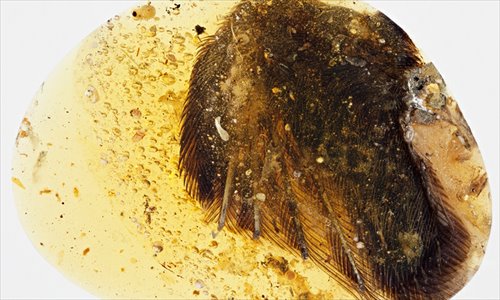HOME >> SCI-TECH
Amber preserving feathers, bones, tissue of dinosaur-age birds found in Myanmar
Source:Xinhua Published: 2016/6/30 15:08:26

The undated photo shows an amber containing an impeccably preserved bird's wing tip. The tiny specimens of baby birds' wings entombed in amber were found in the Hukawng Valley in northern Myanmar and described in the journal "Nature Communications." This is the first time that wings have been found encased in amber. The samples contain two impeccably preserved wing tips with all features intact, including soft tissue, from two birds that scientists believe were hatched nearly 100 million years ago during the Cretaceous period, about 45 million years after the first birds or avian dinosaurs evolved. (Xinhua)
Two chunks of amber unearthed in Myanmar preserving feathers, bones and tissue from nearly 100 million years ago could offer paleontologists a glimpse on the ancestry and evolution of birds, according to media reports Wednesday.
The translucent fossils, nicknamed “Angel Wing” and “Rose”, contain not only feather fragments, but fully intact wing parts complete with skin, flesh and plumage in an alternating pale and brown pattern.
"The biggest problem we face with feathers in amber is that we usually get small fragments or isolated feathers, and we are never quite sure who produced them," said Ryan McKellar of Canada's Royal Saskatchewan Museum. "We don’t get something like this. It’s mind-blowingly cool."
The wing feathers show an advanced degree of development with clearly discernible differentiation between primary asymmetrical flight feathers, secondary feathers, and covert feathers.
These 99-million-year old predecessors to modern birds already possessed flying gear comparable to those still in use today by their distant successors.
Researchers identify the specimens with enantiornithines, a group of avian dinosaurs that became extinct at the end of the Cretaceous period.
They hope that this study will encourage scientists to turn to amber fossils more readily to find new insights into ancient organisms.
Posted in: Discovery